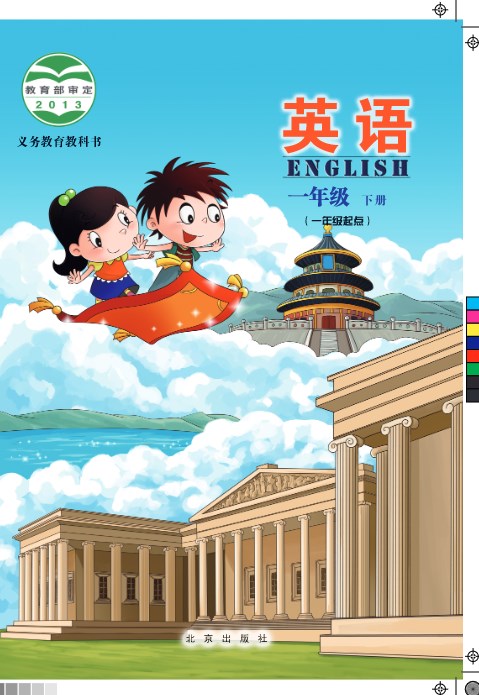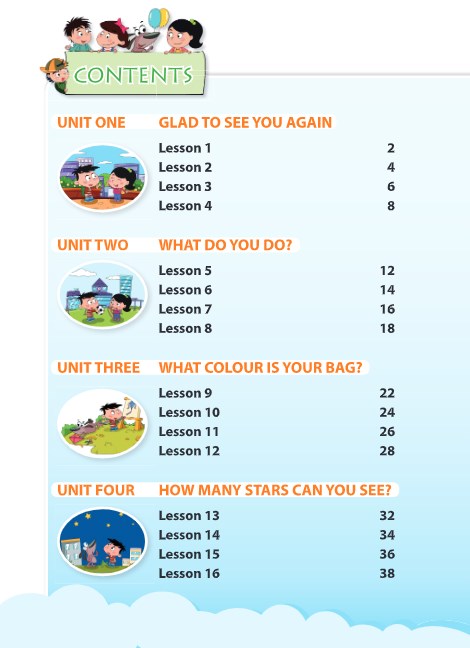英语一年级下册电子课本北京版
其实,北京版的教材逻辑清晰程度相对弱一些,题目相对简单,对学校老师及教研组的要求提出了更高的要求,能够良好的驾驭教材。下面小编为大家带来英语一年级下册电子课本北京版,希望对您有所帮助!
英语一年级下册电子课本北京版


查看完整版可微信搜索公众号【5068教学资料】,关注后对话框回复【1】获取一年级语文、一年级数学、一年级英语电子课本资源。
一年级下册英语知识点整理
1. What do you see? I see a frog/rabbit/bee/bird.
2. What do you hear? I hear a hen/sheep/dog/cat.
3. Smell the noodles, Ben. Taste the soup, Kitty. It’s nice. Yummy. Yummy.
4. I like balls. I like dolls. I like kites. I like bicycles.
5. Do you like sweets/jelly/biscuit/ice cream? Yes./ No. I like…
6. Hello! What do you like? I like water/cola/juice/milk.
7. Spring is green. Spring is warm. Summer is red. Summer is hot.
8. How is the weather? It’s cloudy/sunny/rainy/windy.
9. What do you need? I need a new T-shirt/dress/shorts/blouse.
10. What can you do? I can sing/dance/draw.
What can she/he do? She/He can ride/skip/play/fly.
11. Happy New Year! A gift /card for you, Kitty. Thank you.
12. I’m the wolf/boy/farmer /narrator.
小学一年级下册英语单词表(带音标)
I am (我)是[?m] you 你[ju: ] are (你)是[ɑ: ]
come in. 进来[k?m] name 名字[neim] class 班[klɑ:s ]
good 好的[ɡud] good morning! 早上好! new新的[nju: ]
from 从[fr?m] from beijing 从北京来的 we 我们[wi: ]
chair 椅子[t?ε?] wall 墙[w?:l] ball 球[b?:l]
box 盒子[b?ks] floor 地板[fl?:]
at 在[?t] zoo 动物园[zu:] at the zoo 在动物园里
park 公园[pɑ:k] classroom 教室['klɑ:srum] factory工厂['f?kt?ri]
square 广场[skwε?] capital首都['k?pit?l] China 中国['t?ain?]
the capital of China 中国的首都 love 爱[l?v]
motherland 祖国['m???l?nd] has有[h?z] star 星[stɑ:]
our我们的['au?] national国家的['n???n?l] cap 帽子[k?p]
national flag国旗[fl?ɡ] coat上衣[k?ut] have有[h?v]
long长的[l?:?] short短的,矮的[??:t] big大的[biɡ]
small小的[sm?:l] or或, 还是[?: ] guess 猜[ɡes]
hey 嗨[hei] tall高的[t?:l] old年老的[?uld]
young年轻的[j??] Chinese 中国的;汉语;中国人['t?ai'ni:z]
English英国的;英语;英国人['i?gli?] over 越(过) ['?uv?]
there 那儿[?ε?] over there 在那边 American美国的,美国人[?'merik?n]
other另外的['???] an一(个) [?n] apple苹果['?pl]
orange桔子['?rind?] hand手[h?nd] egg蛋[eɡ]
umbrella 伞[?m'brel?] school is over. 放学了 home家[h?um]
go home 回家 rain 雨;下雨[rein] it's raining. 正在下雨
can't 不能 now 现在[nau] much许多[m?t?]
how much 多少 eleven 十一[i'lev?n] twelve十二[twelv]
minus 减['main?s] here这儿[hi?] here you are. 给你
money 钱['m?ni] they 他(她,它)们 twenty 二十['twenti]
these 这些[?i:z] those 那些[??uz] door 门[d?:]
window窗['wind?u] picture图画['pikt??] talk说话,谈论[t?:k]
about 关于[?'baut] flower花['flau?] some 一些[s?m]
boat 船[b?ut] lake 湖[leik] skirt 裙子[sk?:t]
clean 清洁的[kli:n] shirt (男式)衬衫[??:t] dirty脏的['d?:ti]
cup 杯子[k?p] glass玻璃杯[ɡlɑ:s] picture-book 图画书
have a look 看一看 sure 当然,一定[?u?] and和[?nd]
grade 年级[ɡreid] maths数学[m?θs] your 你们的[j?: ]
their 他(她,它)们的 [?ε?] pioneer 先锋[,pai?'ni?]
young pioneer 少年先锋队员 scarf 领巾[skɑ:f] red scarf 红领巾
both 两[b?uθ] all全部,都[?:l] peasant农民['pez?nt]
soldier士兵['s?uld??] doctor医生[d?kt?] class is over下课了
play 玩[plei] there are 有 do做du: ]
what are they doing? 她们在做什么?pingpong 乒乓 right对的[rait]
join 参加[d??in] them 他(她,它)们(宾格) [?em]
小学一年级下册英语词汇
I am (我)是[?m]
you 你[ju: ]
are (你)是[ɑ: ]
come 进来[k?m]
name 名字[neim]
class 班[klɑ:s ]
good 好的[ɡud]
good morning! 早上好!
new 新的[nju: ]
from 从[fr?m]
from beijing 从北京来的
we 我们[wi: ]
chair 椅子[t?ε?]
wall 墙[w?:l]
ball 球[b?:l]
box 盒子[b?ks]
floor 地板[fl?:]
at 在[?t]
zoo 动物园[zu:]
at the zoo 在动物园里
park 公园[pɑ:k]
classroom 教室['klɑ:srum]
fACTory 工厂['f?kt?ri]
square 广场[skwε?]
capital 首都['k?pit?l]
China 中国['t?ain?]
the capital of China 中国的首都
love 爱[l?v]
motherland 祖国['m?e?l?nd]
has 有[h?z]
star 星[stɑ:]
our 我们的['au?]
national 国家的['n???n?l]
cap 帽子[k?p]
national flag 国旗[fl?ɡ]
coat 上衣[k?ut]
have 有[h?v]
long 长的[l?:?]
short 短的,矮的[??:t]
big 大的[biɡ]
small 小的[sm?:l]
or 或, 还是[?: ]
guess 猜[ɡes]
hey 嗨[hei]
tall 高的[t?:l]
old 年老的[?uld]
young 年轻的[j??]
Chinese 中国的;汉语;中国人['t?ai'ni:z]
English 英国的;英语;英国人['i?gli?]
over 越(过) ['?uv?]
there 那儿[eε?]
over there 在那边
American 美国的,美国人[?'merik?n]
other 另外的['?e?]
an 一(个) [?n]
apple 苹果['?pl]
orange 桔子['?rind?]
hand 手[h?nd]
egg 蛋[eɡ]
umbrella 伞[?m'brel?]
home 家[h?um]
go home 回家
rain 雨;下雨[rein]
it's raining. 正在下雨
now 现在[nau]
英语一年级下册教学设计
教学目标:
1、知识目标
(1)能够理解,听懂并认读以下单词及词组:should, shouldn’t, cross, dangerous, hold, hand, say, in a hurry.
(2)能够理解并运用以下句型
You should…。 / You shouldn’t…。
2、能力目标
(1)能够使用You should…。 / You shouldn’t…。两个句式描述应该做什么,不应该做什么,进而使学生能够用这两个句式表达生活中常见的“Manners”。
(2)通过师生问答,自由对话等活动,提高综合语言运用能力。
3、情感目标
(1)能够通过谈论应该做什么,不应该做什么来培养孩子良好的生活习惯和行为规范。
(2)通过学生之间互问互答,小组活动等培养学生的合作意识。
(3)通过积极评价与活动展示等方式树立学生学习英语的自信心。
教学重点:
能够正确使用You should…。 / You shouldn’t…。 两个句式描述应该做什么,不应该做什么。
教学难点:
(1)能够正确使用You should…。 / You shouldn’t…。 两个句式描述应该做什么,不应该做什么。
(2)Dangerous,shouldn’t, cross的正确发音。
教学策略:
1、教法设计
本课以任务型教学法为主,给学生设置多个任务,通过完成任务,完成教学目标。根据英语这门课本身的特点及五年级学生的兴趣,我通过设计具体、形象的情景,以旧带新,不断滚动知识点,以此来分散教学难点,让学生直观地感知与理解。同时创设数个活动,使学生在师生、生生之间的多向交流中进行有意义的练习与实践,充分发挥他们的学习主体性,培养他们学以致用的能力。
2、学法指导
引导学生通过倾听、猜测的方法逐渐感悟新语言项目的功能,让学生在多层次的练习中体会到学习英语时“运用”的必要性,鼓励学生积极思维,大胆尝试。
3、教学手段
根据本课的教学内容、教学目标、学生的年龄特征和心理特征,为了更好地激发学生学习兴趣,从而能积极主动参与学习。教学中运用多媒体课件、图片等教学辅助手段,置抽象的句型于一个个生动的情景之中,不仅使学习过程自然轻松,更能较好地启智开思。
4、教学环境
教室内配备多媒体设备,能够将信息技术与英语教学相结合,为学生提供丰富多彩的语言材料。将学生分成四个小组,进行小组合作式学习。
教学准备 :
多媒体课件, 单词卡片,句子卡片。
教学过程:
1、Leading-in
①Teacher and the students greeting each other.
②Ask and answer to present the new lesson.
T: (show a clock, the hand of the clock point at eight sharp)?
T: What time is it?
Ss: It’s eight o’clock.
T: What time do you go to school?
Ss: …。
T: How do you go to school?
Ss: …。
T: How does Tom go to school? Do you know? You can guess.
Ss: …。
设计意图:通过问候拉近与学生之间的距离,为后面的交流做好铺垫,同时自然呈现本课所要进行的任务。通过猜猜的环节抓住学生的注意力,为后面播放录音打好心理基础。
2、Pre-task
T: (Play the CD- ROM )
Now, listen and think about it- How does Tome go to school?
Ss: Tom walks to school.
T: When we walk, what should we do , and what shouldn’t we do?
Now, Listen again and find the answers with the group discussion.
Then fill in the blanks.
You should…。 ( √)You shouldn’t …。 ( × )
设计意图:呈现任务,让学生带着问题去听,去思考。对课文有初步了解,能够理解should, shouldn’t 的含义。小组讨论完成表格,让优生带动基础较弱的学生,合作式学习,提高学习效率。
3.While-task
T: Who can give the answer to us?
Ss:
T: Maybe you are right. Let’s look, listen and say. Then make sure your answers are right.
T:(Present the right answer. )
T: Why we shouldn’t walk in the road?
Ss: It’s dangerous.
设计意图:教师不要急于给出答案,让学生再听一遍并跟读,使孩子们再次思考,自查答案。体现学生学习的主体性。学生在汇报的过程中,教师纠正发音,句子表达。从而让学生对 You should …。 /You shouldn’t …。 句型有更深刻的理解。
4.Post-task
T: (Show some pictures and words bank as the following )
Each group has one picture. Group discussion to give the sentences:
You should … in/at…。/ You shouldn’t …in/at…。
Picture1:In the park, a boy climb the tree, a girl walk on the grass
Words bank: climb the tree, a girl walk on the grass, fly kites,…
Picture2: In the classroom. Sleep in class, write , read a book, clean the floor…。
Words bank: sleep in class, write, read a book, clean the floor…。
Picture3: At home: clean the floor, help mum, cook fish, jump on the bed
Words bank: clean the floor, help mum, cook fish, jump on the bed, play too much computer games, watch too much TV…
Picture4: On the way home:
Words bank: play in the road, walk in the road, look, then cross the road…
设计意图:给每个小组不同的任务,进行组内讨论,要求每位组员都要表达出一个完整的句子,使用本课的功能句型: You should …。 /You shouldn’t …。后每组选出两人进行汇报,教师进行总结,同时对学生进行情感教育,培养孩子的良好的生活习惯。
5、Homework
①Read the text on P 30 three times after the tape.
②使用句型“You should…”或“You shouldn’t…”写出我们在周末应该做或不应该做的事,例如:“You shouldn’t watch too much TV.”(分别至少写3句话)
6、Blackboard writing
You should…。 look, then cross the road.
say hello to …
hold … hand
You shouldn’t…。 walk in the road-- dangerous


